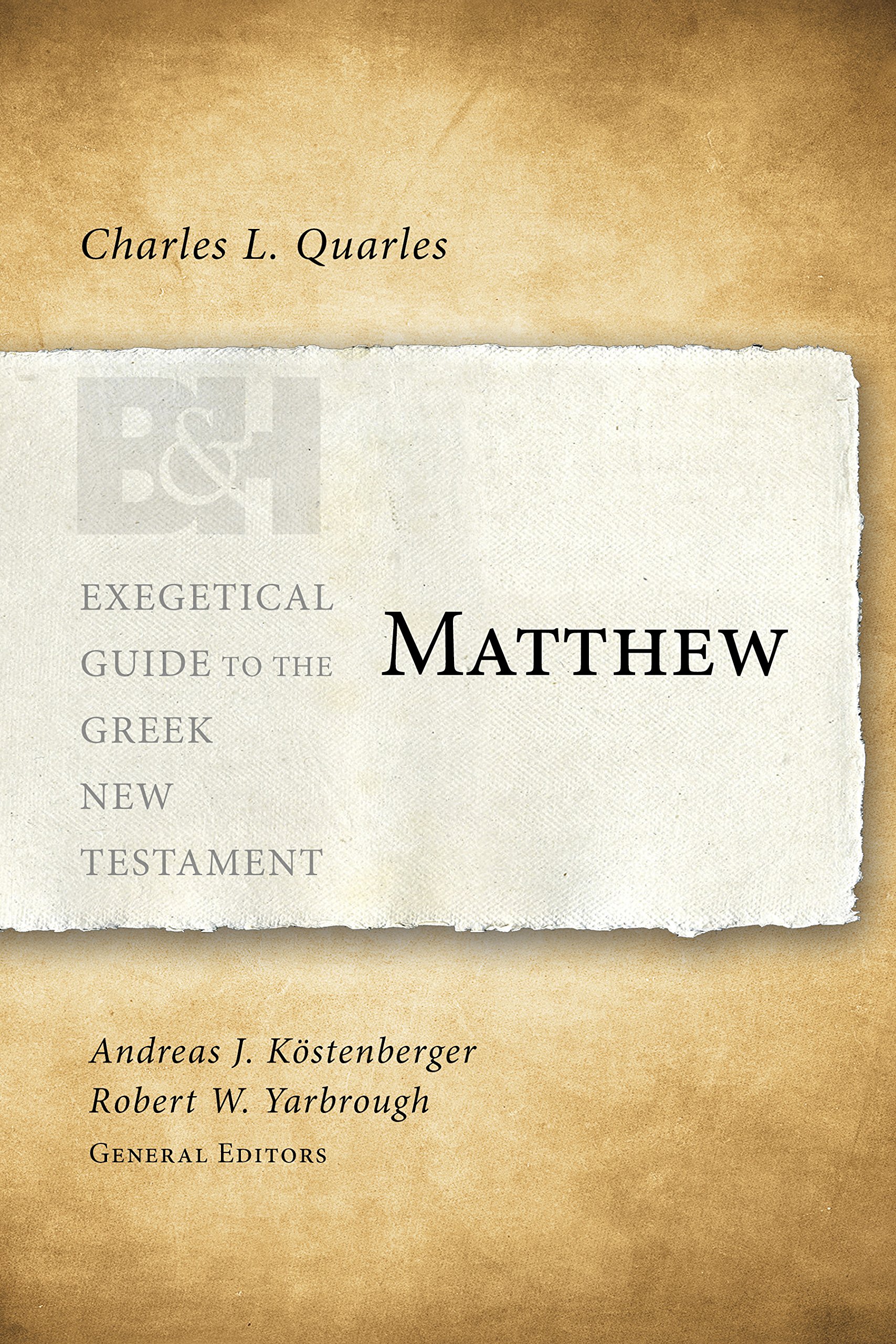A Book Review from Books At a Glance
by Tim Moschera
Charles Quarles is Research Professor of New Testament and Biblical Theology at Southeastern Baptist Theological Seminary in Wake Forest, NC, where he also holds the Charles Page Chair of Biblical Theology. Although Quarles’s publications span multiple fields in biblical studies, the greatest concentration of his work has been in the Synoptic Gospels and especially the Gospel of Matthew. In recent years, he has published Sermon on the Mount: Restoring Christ’s Message to the Modern Church, NAC Studies in Bible and Theology (Nashville: Broadman & Holman, 2011), A Theology of Matthew: Jesus Revealed as Deliverer, King, and Incarnate Creator, Explorations in Biblical Theology (Phillipsburg, NJ: P&R Publishing, 2013), and is currently writing a commentary on the Gospel of Matthew for the Biblical Theology for Christian Proclamation series.
This volume belongs to the Exegetical Guide to the Greek New Testament series (EGGNT), which is not a full-scale commentary but “aims to close the gap between the Greek text and the available tools [e.g., intermediate grammars]” and thereby to make interpreting the Greek text of the NT easier, particularly for those who want to preach the Scriptures with accuracy and authority but are hard-pressed for time (xxxv).
The book opens with a nine-page introduction, providing brief treatments of the traditional introductory matters. The author argues that the Gospel was written by the apostle Matthew in the 60s but is not firm on the provenance or language of composition. He explains the structure in a way that gives attention to the chronological and geographical progress of the narrative as well as the importance of the five discourses. The introduction concludes with Quarles’s short list of twelve recommended commentaries.
In the main portion of the book, Quarles has divided Matthew into small sections as determined by his outline of the Gospel and works through the Greek text verse-by-verse. As with all the volumes of EGGNT, the analysis is based on the text of the United Bible Societies’ Greek New Testament, 5th ed. (UBS5) in which the text of Matthew remains unchanged from the third and fourth editions). For each verse, Quarles provides parsing information for all finite verbs, explanations of the meaning and/or syntactical function of particles, such as prepositions and conjunctions (e.g., the difficult Matthean uses of τότε), identifications of the syntactical function of participles (e.g., genitive absolute, attendant circumstance, temporal), explanations of exegetically relevant cases (e.g., genitive of product, genitive of possession), and occasionally, explanations of the meaning communicated by verbal tense-forms (e.g., the use of an aorist to express urgency). Explanations of lexical meaning are minimal, as are treatments of text-critical problems (apart from occasional exceptions, such as the 1½-page treatment of 16:2b–3, the reader is usually referred to the treatment in Metzger’s Textual Commentary). Due to the length of Matthew, full diagrams are not included, as they are in other EGGNT volumes.
The terminology employed is that of traditional grammar rather than that of modern linguistics and therefore should be accessible to all. In a similar vein, Quarles is clearly aware of recent studies in discourse analysis and its application to the narrative of the NT, as evidenced, for example, by his comments on the function of καί and δέ on page 4 in relation to the work of Stephanie Black, Sentence Conjunctions in the Gospel of Matthew, such comments as “the δέ marks a new development in the narrative” (28), his references to the works of Stephen Levinsohn and Steven Runge, and the suggestion that the imperfect tense-form may mark background material (33). However, the reader should not expect to find an extensive and explicit deployment of discourse analysis.
Each section concludes with “homiletical suggestions,” which are essentially suggested sermon titles and outlines. For example, the homiletical suggestion for 3:1–6 is as follows:
John the Baptizer (3:1–6)
- John’s message emphasized repentance
- John’s ministry fulfilled prophecy (Isa 40:3)
- John’s mission was to prepare for the coming of God
- John’s manner associated him with Elijah (2 Kgs 1:8)
- John’s mandate was the baptism of confessing sinners
With so many voices encouraging pastors to stray further from the text in their sermons, these suggestions should encourage pastors to give the text a more central role by helping them to bridge from exegesis to homiletics without leaving behind the former.
Throughout the book, Quarles has also included lists of suggested resources for further study, covering 152 topics. With the ever-growing mountain of secondary literature on Matthew, only the Matthean specialist can summit it; therefore, the reader will be well served by these recommendations from one with a view from the top. The suggestions tend toward the technical with monographs and journal articles from periodicals such as Novum Testamentum and the Journal for the Study of the New Testament but are limited to English-language resources and so should be accessible to the intended readers of this book.
The end matter includes a thorough, exegetical outline of Matthew, as well as grammar and Scripture indices.
This volume will be most useful to pastors who possess at least a basic facility with Greek and desire to engage the Greek text in their sermon preparation. It is not a full commentary and therefore will need to be supplemented by other commentaries, such as those recommended by Quarles on pages 10–11. Furthermore, the reader will not find extensive and thorough weighing of grammatical and syntactical options, interaction with other scholars, or defense for each of the decisions, but the reader can be sure that such work does form the basis of the judgments offered by Quarles. Despite this, the book may provide the most consistently thorough treatment available of the grammatical and syntactical issues in Matthew. For this reason, it will likely also be useful to the more advanced student of the Greek NT.
Tim Moschera is a Th.M. student at Southeastern Baptist Theological Seminary.
